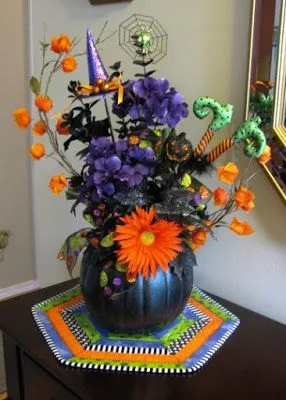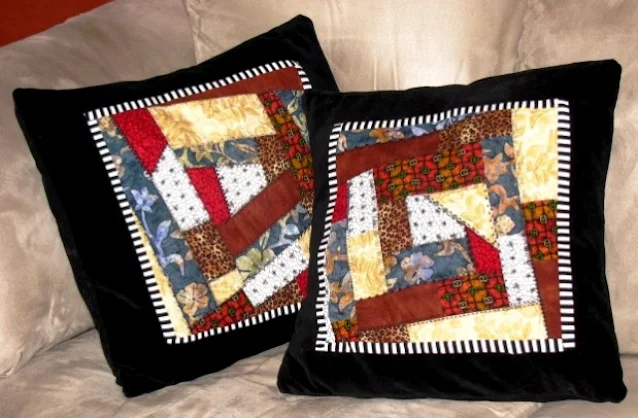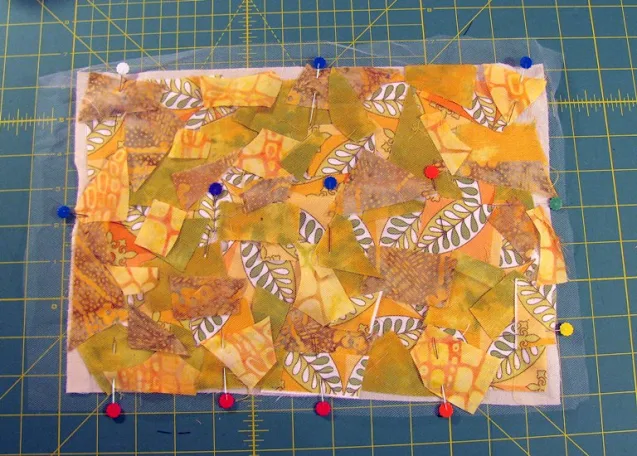Halloween is my favourite time of year. I did this floral arrangement for the season and made a Halloween table topper to go with it. I think the whole thing looks quite cheerful. Also, check out my Halloween door wreath.
Sewing machine cover from an old art quilt
I made a sewing machine cover with an old art quilt that hung in our office. I had been trying out improv aka free form quilting for the first time and created this mini quilt Summer Aspen. I love the colours but grew tired of it on the wall.
I used Rayna Gillman's book Create Your Own Free-Form Quilts to make this quilt art. This book guides you along very well and has beautiful examples of some of Ryana's pieces.
At first, I thought it might look nice as a bag, but I changed my mind about that and decided to turn it into a sewing machine cover. I love how it turned out.
I used Rayna Gillman's book Create Your Own Free-Form Quilts to make this quilt art. This book guides you along very well and has beautiful examples of some of Ryana's pieces.
At first, I thought it might look nice as a bag, but I changed my mind about that and decided to turn it into a sewing machine cover. I love how it turned out.
Crazy quilt pillows with video tutorial
I made these crazy quilt block pillows for our couch, and they really inject a bit of character into the room. I love crazy quilts but lack the patience and time for all that embroidery. So, now I use the fancy stitches on my sewing machine instead. My little Singer has the best decorative stitches, so I use that machine for crazy quilt blocks.
Below is a great tutorial by Fons & Porter for creating crazy blocks. (FYI: The quilt in the left background inspired my denim scrap quilt beach blanket.)
Below is a great tutorial by Fons & Porter for creating crazy blocks. (FYI: The quilt in the left background inspired my denim scrap quilt beach blanket.)
My new studio desk
I'm very proud of this little desk I created from a vintage sewing machine. I think the machine is circa 20s or 30s. I got it free from a friend of a friend, and it sat in my studio gathering dust for over a year until I finally had the time to make it useful. Some may think it's sacrilegious to hack a vintage machine like this, but it makes a great desk. I'm amazed at how much I could fit into those four little drawers.
Spirit Dancers Art Quilt
This is my art quilt Spirit Dancers. I created this piece for a local art show called Stone Age. It was the first art show I'd been in, so I was pretty excited. I think my piece was the only fabric art in the show.
I sold the piece quickly and then received a call from the gallery curator. Someone from Australia also wanted one before they flew back home. I then had to rush around to make a duplicate. I was lucky to still have some of the hand-dyed fabric I used.
I sold the piece quickly and then received a call from the gallery curator. Someone from Australia also wanted one before they flew back home. I then had to rush around to make a duplicate. I was lucky to still have some of the hand-dyed fabric I used.
 |
| Monica at the Stone Age art show with her fabric art Spirit Dancers |
How To Make Fabric Foundations for Fabric Art
Fabric sandwiches were incorporated into my art quilt Mother Ship that's on the Fall 2012 Quilting Arts Magazine cover in Fall 2012.
 |
| Sister Moon by Monica Curry |
 |
| Knowledge by Monica Curry |
INSTRUCTIONS
YOU WILL NEED
2. MIDDLE LAYER
3. TOP LAYER
- Fabric scraps.
- Lightweight muslin or any lightweight non-stretchy fabric cut to 9 x 12 inches.
- One piece of tulle cut to 11 x 14 inches.
- Thread
- Pins
- Sewing machine
1. FOUNDATION LAYER
Start your sandwich with a lightweight, non-stretchy, foundation piece approximately 9 inches by 12 inches. This is the easiest size to work with. I use a light, inexpensive muslin for the foundation, but anything lightweight and non-stretchy will work. You can also use a coloured foundation that works with the scrap colours.
Pick the colours you want to work with. You can use monochromatic colours, contrasting colours, or grab a bunch of random colours. Start placing your fabric scraps down on the foundation until you've covered it as much as you can.
3. TOP LAYER
After all the scraps are put down on your foundation layer, cover these two layers with a piece of tulle about two inches wider than your foundation piece (11" x 14") giving you an overhang of 1 inch all the way around. Pin these three layers down around the edges and in the middle.
6. When you’ve completed stitching your grid, you now get a chance to use some of those decorative stitches you have on your sewing machine. If you’re like me, you may not use them very often. Pick a decorative stitch and, starting at one edge of the sandwich, sew to the other edge. There is no hard and fast rule about this. Just pick out a bunch of nice stitches to use and sew along the sandwich randomly. I experimented with my alphabet stitch for this project and really liked the outcome. You can also use free-motion stitching which can produce some beautiful results.
7. When all your stitching is complete, trim the excess tulle along the outer seam line to clean up the edges. I do this because I find the excess tulle snags on things when you work with the sandwich later.
8. Turn the sandwich over face down and press on the wrong side so you don’t gum up your iron with melted tulle. You can see in this photo the grid width and where I’ve sewn the decorative stitches randomly across the sandwich.
4. STITCH AROUND OUTER EDGE
Once the three layers are pinned securely, stitch around the edge of the sandwich with a basting stitch creating a seam width of about 1/2 inch.5. QUILT
After you’ve sewn around the edge, sew a line across the length and the width of the sandwich. Then stitch a grid at least 3" in width. Your grid can be as small as you like, but don’t go wider than 3" because your scraps could start to shift around too much during the next step.6. When you’ve completed stitching your grid, you now get a chance to use some of those decorative stitches you have on your sewing machine. If you’re like me, you may not use them very often. Pick a decorative stitch and, starting at one edge of the sandwich, sew to the other edge. There is no hard and fast rule about this. Just pick out a bunch of nice stitches to use and sew along the sandwich randomly. I experimented with my alphabet stitch for this project and really liked the outcome. You can also use free-motion stitching which can produce some beautiful results.
7. When all your stitching is complete, trim the excess tulle along the outer seam line to clean up the edges. I do this because I find the excess tulle snags on things when you work with the sandwich later.
8. Turn the sandwich over face down and press on the wrong side so you don’t gum up your iron with melted tulle. You can see in this photo the grid width and where I’ve sewn the decorative stitches randomly across the sandwich.
TIPS
- Sprinkle thread, ribbon, yarn, or lace scraps on top of the fabric layer before adding the tulle layer.
- Try using a foundation piece made from used dryer sheets that have been stitched together.
- Print images or lettering on fabric that can be incorporated into the scrap layer.
- If the piece isn’t going to be washed, add bits of pretty paper or newsprint to the scrap layer.
- Use a foundation piece colour to coordinate with the scraps.
- Experiment and have fun!
My Hat From a Life Lived: Empty Nest
 |
| The Empty Nest Art Hat by Monica Curry |
“When [Anastazja Urbanik] passed on at the age of 94, I received many of her hats. Now my project, Hats From a Life Lived, gives the opportunity to many artists to express an aspect of their life. The participants adapt a hat from another life to give it a new life."
Colette Balcaen
I grew up during a time when women were often defined by their ability to have children. So, the experience of infertility and subsequent miscarriage forced me to explore my place in the world as a woman without children. Over the years, I’ve learned that the power of the feminine goes beyond childbearing. I’ve embellished the “nest” of the piece to accentuate the rich life I’ve had without children. The spiral of the piece represents the feminine life force. With or without children I believe this powerful force runs through all women and is our source of their strength and creativity.
Subscribe to:
Posts (Atom)




























